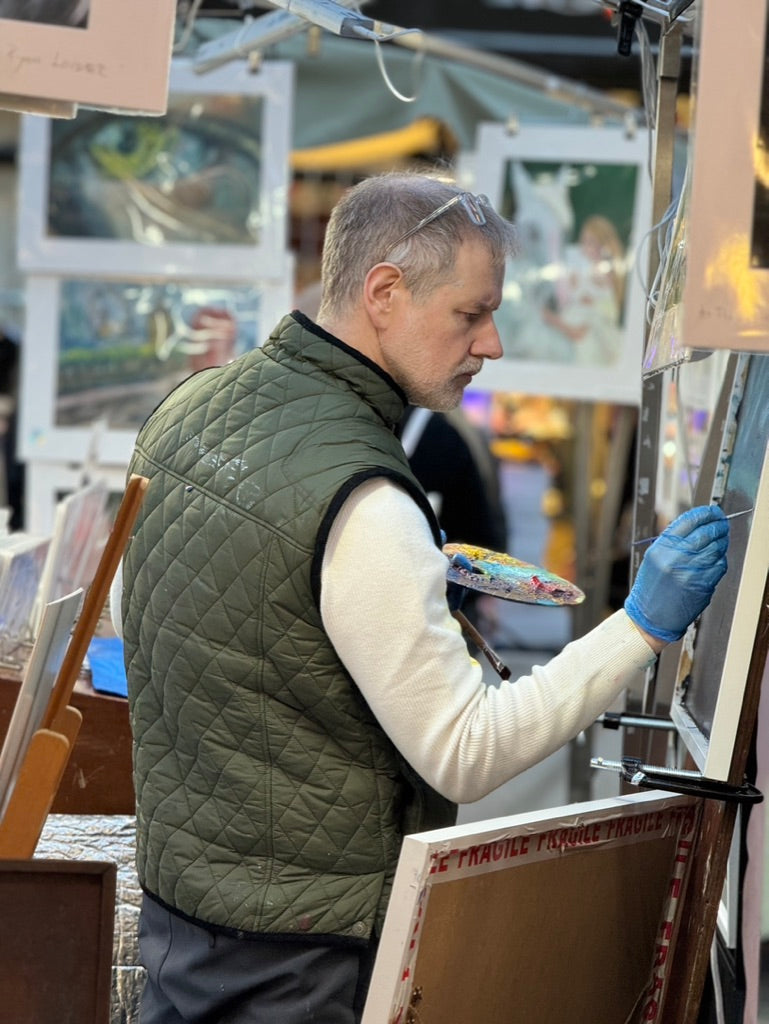
How to Thrive as an Artist in the Age of AI
Share
 How to Thrive as an Artist in the Age of AI (Without Losing Your Identity)
How to Thrive as an Artist in the Age of AI (Without Losing Your Identity)
The art world is undergoing a seismic shift. AI-generated content is rapidly improving, surpassing human-created digital art in many areas. The promise of infinite content, quality, and accessibility presents both a challenge and an opportunity for artists. How do you not only survive but thrive in this new landscape? How do you maintain your artistic identity and confidence when faced with the potential displacement of your skills?
The Shift: Recognizing the Changing Landscape
The rise of AI necessitates a fundamental reevaluation of artistic practice. While digital creation has offered incredible tools and possibilities, it's becoming clear that competing with AI on a purely technical level is a losing battle. AI excels at efficiency, precision, and prolific output. If your artistic focus lies solely within the digital realm, you need to adapt. AI isn't just on the horizon; it's already here, and it's changing the game.
The Power of the Physical: Reclaiming the Human Touch
The key to navigating this shift lies in recognizing the enduring value of the physical. Humanity has never prized things solely for technical perfection. We value the human touch, the imperfections, the process, the story behind the creation. This is why handmade furniture, despite the prevalence of mass-produced alternatives, continues to hold a special appeal. It's why we're captivated by videos of artisans crafting objects by hand. It's the tangible connection to human skill and experience that resonates.
While there may be a fleeting fascination with AI-generated art, its long-term value is questionable. The essence of art is the human condition – our emotions, struggles, and unique perspectives. AI can mimic these elements, but it cannot authentically embody them.
Emotion vs. Intelligence: The Artist's Unique Advantage
Artists cannot compete with AI on pure intelligence or technical skill. However, AI fundamentally lacks emotion – the very essence that makes art meaningful. Rawness, imperfection, and emotional depth are what distinguish human art from machine-generated content. To thrive, artists must lean into these uniquely human qualities. Embrace the flawed, unpredictable, and beautifully chaotic nature of human experience.
Navigating the "Ego Death" of the Digital Age
The rise of AI can be seen as an "ego death" for humanity, forcing us to confront the reality that we are no longer the sole possessors of advanced intelligence. AI is surpassing us in many cognitive areas, and this trend will likely continue. We are entering a world where AI plays an increasingly prominent role, perhaps even a dominant one. The challenge lies in preserving our humanity in this new reality.
Humanity possesses something AI lacks: emotion, lived experience, and irrationality. We are driven by a fundamental need for meaning, even in the absence of external pressures. Even if AI were to eliminate work and struggle, we would likely find new avenues for creative expression and challenge.
The Artists Who Will Thrive (And Those Who Won't)
Artists who embrace physical creation – painters, sculptors, performers, craftspeople – are best positioned to thrive in the age of AI. Photographers can also find a path forward by returning to traditional film, handcrafted processes, and unique, tangible prints. AI can generate perfect images, but it cannot replicate the experience and artistry of traditional photography.
Painters focused solely on hyperrealism will face challenges. If the goal is simply to replicate a photograph, AI can already do it more efficiently. However, artists who create emotionally charged, expressive work will continue to resonate.
Artists who rely heavily on assistants for execution, minimizing their own direct involvement, may find themselves easily replaced by AI.
The Importance of Authenticity: Why I Don't Use AI for My Art (Yet)
While AI tools are readily available, choosing not to use them indiscriminately can be a powerful statement. Simply generating an image with an AI prompt is not the same as artistic creation; it's more akin to curation. There is a crucial distinction between using AI as a tool and abdicating artistic authorship. The line blurs when artists present AI-generated content as their own original work. Transparency and honesty are essential.
The AI era will serve as a "great filter" for artists. Those who cling solely to digital creation will likely struggle. Those who embrace the physical, the flawed, and the emotional will find a way to connect with audiences on a deeper level.
The Future is Physical (Even If It's Digitally Shared)
The emphasis on physical creation doesn't mean abandoning digital platforms. Social media, online marketplaces, and digital distribution channels are vital for reaching audiences. The key is to use digital tools to share physical art, not to create it. AI can scrape and learn from digital images, but it cannot replicate the tangible, unique qualities of a physical artwork.
Embrace Your Madness: The Uniquely Human Element
In the age of AI, the most valuable asset an artist possesses is their humanity. Embrace your flaws, your chaos, your unique perspective. Lean into the qualities that make you human, because these are the very things that AI can never truly replicate. It's the artist's personal journey, their struggles, and their unique way of seeing the world that resonates with audiences.
Art is not dead; it's evolving. The future of art lies in reclaiming the power of the physical, the emotional, and the uniquely human. By embracing these qualities, artists can not only survive but thrive in the age of AI.